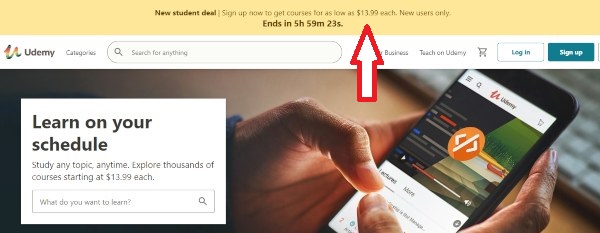What is FOMO marketing?
FOMO is the anxiety people feel when they believe that they’re missing out on something exciting. It is an abbreviation for “fear of missing out”.
FOMO marketing is simply the use of strategic marketing tactics to induce in consumers that fear of missing, forcing them to make impulsive purchase decisions.
How FOMO marketing works
The accessibility of information on the internet has made many people develop an appetite for researching things. For example, before buying products online, the average consumer will spend hours reading reviews and comparing prices on different websites. Nearly 70% of people will not buy anything online before reading reviews.
Our craving for information is driven by the fact that we’re risk-averse creatures and always want to know the pros and cons before making decisions.
If we see that’s something is no good for us, then we’d rather stay away from it than live with regret for making a poor decision. And if we see that something is good for us, we start to crave it even more, and the last thing we’d want is to miss out on it.
Let’s say you’re considering to upgrade your smartphone with the latest iPhone, however you’re not sure whether it’s worth the money. And then you suddenly come across an ad saying that it is currently available at a discounted price – but only for the next 24 hours. Chances are you’ll hop onto the opportunity without even thinking twice.
And if you were to miss out on it and later had to pay the full price, you’d hate yourself for not taking action when you had a chance to.
The reason FOMO is such a powerful marketing weapon is because it leverages people’s distaste for regret for forces them to take action immediately.
FOMO marketing examples
Amazon
Amazon triggers FOMO in its users by showing the number of products left in stock. If the stocks are low, then the products are in high demand and will probably run out soon. There are several FOMO marketing examples that use the same principle.

Booking.com
Similar to Amazon, Booking.com displays how many rooms a hotel has available. When people see that only a few rooms are remaining (as is often the case on most of the listings), then they’re more likely to make their booking right away. It’s a simple trick that can help drive more sales.

Booking.com also shows whenever people miss out on opportunities, such as when the only remaining room gets booked. That intensifies their FOMO and forces them to be more decisive.

Udemy
Udemy leverages FOMO by offering its courses at substantial discounts – however only for a set amount of time. A countdown timer shows how much time is remaining before the offer expires.

Effective FOMO marketing strategies
1. Start by building social proof
Social proof is the idea that humans are psychologically conditioned to copy each other. It is the reason why products like iPhones and MacBooks are extremely popular despite being significantly more expensive than their competitors.
Businesses that are built on a foundation of social proof appear more credible in the eyes of their target audience. Such credibility, when paired with FOMO, can drive people crazy. Without social proof, the rest of your FOMO marketing strategies are unlikely to work because consumers just won’t care enough.
There are numerous ways to build social proof. For example, you can start proactively collecting ratings and reviews from your customers and then displaying them on your website and social media pages.
Most buyers conduct some research before purchasing anything, and reviews are often the first thing that catches their eye. A business with many positive ratings and reviews easily stands out from its competitors and becomes the obvious choice for them.
Another great way to build social proof is by featuring customer success stories on your social media pages and blog posts. That gives the impression that people are actually using your products and finding success with them.
2. Set strict deadlines
We are trained to respect deadlines from a very young age. Our parents would give us strict deadlines to accomplish tasks in the house, as would our teachers in school, and even as grownups, our employers. It’s almost as though we need them to function properly.
Deadlines are also the backbone of FOMO marketing campaigns. They put people under pressure and force them to take action with urgency. For example, if plane tickets are available at a discounted price, but only for 2 hours, more travelers are likely to make their booking during that short window.
Once a deadline has expired, the deal that was advertised should no longer be valid. If people find out that it was just a bluff and that they can still access it somehow, then the company loses credibility.
When a deadline expires, it should expire for real. The people who missed it should regret not taking action when they could. Next time such an offer comes their way, they’ll be on their toes.
3. Early bird offers
If you’re launching new products or selling tickets to an event, you can offer early bird deals to a limited number of people. For example, you could offer a 20% discount to the first 100 customers, or a free cocktail to the first 50 people to buy tickets to your event.
Early bird offers are a great way to get the ball rolling and make people start talking about your business. Not only will you benefit from the rapid sales, but also from the word of mouth and FOMO that will be ignited.
4. Exclusive offers for a set number of people
While early bird deals are can only be used when launching new products or selling tickets, the idea can be replicated by offering exclusive deals to a set number of people. For example, you could offer a discount or a complimentary gift to the first 100 people to buy your products on a holiday such as Easter.
Make sure to promote the exclusive offers aggressively through all your channels to get word out to as many people as possible.
5. Exclusive offers only available on certain channels
This is a great way to get your target audience to respond to your call-to-action on specific channels. For example, if you’re looking to increase your app downloads, you can create a deal that’s only accessible via the app, and then advertise it on social media to create a FOMO.
Similarly, if you’re looking to grow your Facebook following, you can create an offer that is only available to your Facebook followers and then advertise it on Twitter. If you’re looking to grow your email list, you can create deals that are exclusive to your email subscribers. You get the gist.
6. Get influencers to hype your products
Influencer marketing can help accomplish numerous things, such as create brand awareness, build social proof, and even create FOMO. Many businesses have made it their primary marketing strategy because of how effective it has proven to be. According to Forbes, it is growing faster than all other types of digital ads.
A study conducted by Linqia showed that influencer marketing involving micro-influencers yields far greater results, especially in terms of engagement rates. This is because micro-influencers have a more positive relationship with their followers, which makes it easier for them to be recommended as a brand ambassador.
Many brands have turned to micro-influencers in an effort to increase their marketing efforts. However, this can be quite difficult because there are so many micro-influencers to choose from. If you don’t know where to start, you can always ask a marketing agency to do the work for you as they have the resources to find the right influencers. You can also use influencer networks such as GRIN and Uplfuencer.
If you can get influencers to actively promote your products as though they’re existing customers, or better yet, to promote your limited-time discounts and exclusive deals, it can spark a FOMO frenzy.
7. Get celebrities on Cameo to talk about your products
Cameo is a website where people can get celebrities to record short and personalized videos for a small fee. It has thousands of celebrities available, from boxing champions like Floyd Mayweather to rappers like Ice Cube.
You can get a celebrity who is idolized in your community to promote your products or hype your exclusive deals. Just like with influencer marketing, that can increase your social proof and intensify the FOMO tenfold.
And the best part is that it’s very affordable, with prices ranging from around $5.00 to $200.00 for a 15-second video. For the price of a movie ticket, you could even get a famous movie start to record a video for your business.
But not just any 15-second video. Only the highest quality ones. The celebrities often record videos in studios that produce high definition content, and they can even supplement the video with pictures, audio messages or both.
8. Create product bundles
You can create bundles by putting together a selection of products, and then selling the whole unit at a discounted price. So instead of buying single items, consumers would rather buy the bundle because it contains more value both in price and quantity of products they’re getting.
Restaurant chains have perfected this FOMO marketing tactic. For example, KFC has a combo that comes with fries, 3 pieces of chicken, and a soda. Such an offer enables them to sell more items than if they focused on selling each item individually.
You can add the FOMO factor by making the bundle only available for a limited time or by making it exclusive to certain channels e.g., your app.
9. Use trigger keywords in your messages
The words you choose when communicating with consumers are key in your FOMO marketing campaign. Your messages should create a sense of urgency and make it clear that your offers are exclusive and will soon not be available. Your goal is to convince customers that they are taking advantage of a rare opportunity.
Some trigger keywords you can use include:
- “Here’s an exclusive deal just for you!”
- “Hurry! This offer expires soon”
- “Few spots remaining”
- “This is your last chance”
- “Time is almost running out”
10. Add an exit-intent popup on your website
Exit-intent popups show up right before a visitor leaves a website. They are usually initiated when the browser detects the mouse pointer moving towards the “close” button. This is done using Javascript or detecting the active pointer using CSS.
Exit-intent popups are effective because website visitors usually have a reason to leave your website. The most obvious reason is that they found what they were looking for and their goal was completed, or maybe there was nothing on the site that they liked.
At other times visitors leave a website because of distractions or lack of time to complete their tasks. Maybe the loading is taking too long or other distractions that pop up all over the place.
This is where exit-intent popups come in and provide a nice solution that prompts the visitor to stick around and gives them a chance to complete their goals.
For example, it’s well known that people love free stuff. So, what if your exit intent popup offers a free ebook or checklist? You might think that nobody would take the bait and fill out their name for a free gift, but you would be wrong.
This technique has been tested over and over again with proven conversion results. People will fill out a form if it’s free and they get something in return.
The popup can once again highlight your exclusive offer and remind the visitor that they’re going to miss it if they leave your site. You can even throw in an additional bonus to encourage them to proceed with the order.
If you built your website using WordPress then you can find countless plugins with the exit-intent feature, including Ninja popups and OptinMonster.
11. Social media contests
Doing contests is one of the most effective FOMO marketing techniques for getting people to talk about your brand on social media. They can take many different formats.
For instance, you can get your followers to share a testimonial about your products to enter the draw to win something. Be generous with your prizes to get many people to participate.
If you can get just 100 people with around 500 followers to take part in the contest, their testimonials could be seen by up to 50,000 people from their networks. The brand awareness, social proof, and FOMO generated will be invaluable for your business. People are more easily influenced by recommendations from their friends than a business’ self-promotional efforts.
Conclusion
FOMO is such a powerful marketing weapon because it drives people to take action immediately. It forces them to buy before they’ve had time to think about the consequences.
FOMO marketing capitalizes on fear, which is why it’s such a popular marketing tool. Our fears have been shaped over hundreds of thousands of years. It’s human nature to value survival above all else because those who didn’t value survival were killed off in the early days.
We’re still wired with that instinct today, even though most of us don’t have to worry about being eaten by a lion.
FOMO marketing techniques have been slowly inserting themselves into our lives, until they’re now used on all types of products and services. If you can find a place for it in your digital marketing strategy, you can build a brand that’s irresistible to consumers.



